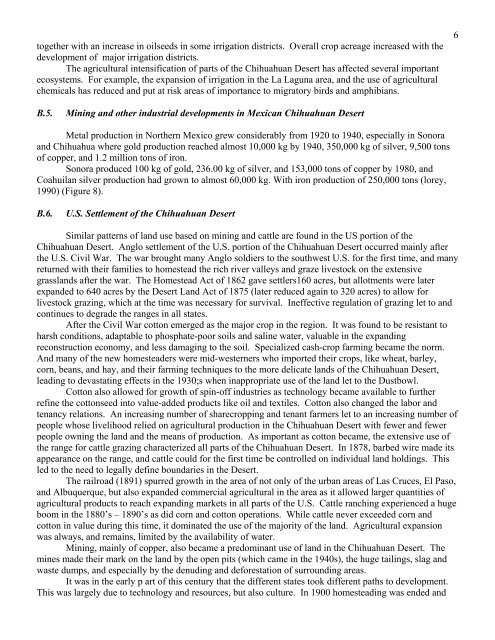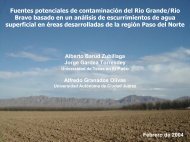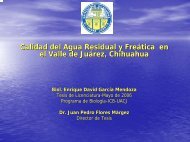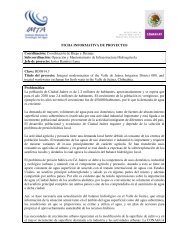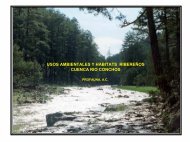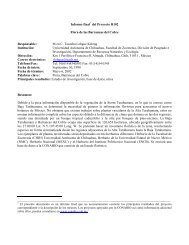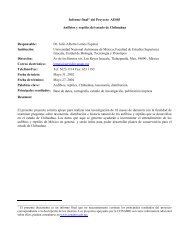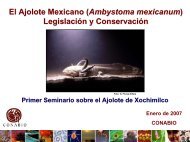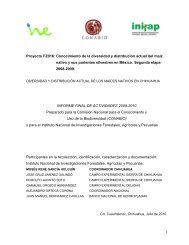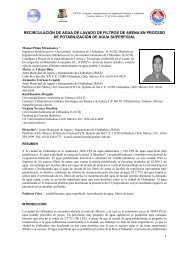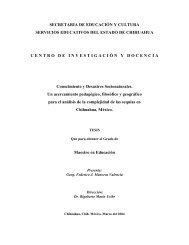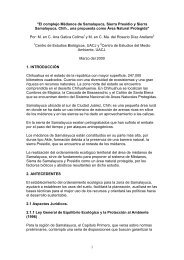land use and land tenure change in the - El Colegio de Chihuahua
land use and land tenure change in the - El Colegio de Chihuahua
land use and land tenure change in the - El Colegio de Chihuahua
You also want an ePaper? Increase the reach of your titles
YUMPU automatically turns print PDFs into web optimized ePapers that Google loves.
toge<strong>the</strong>r with an <strong>in</strong>crease <strong>in</strong> oilseeds <strong>in</strong> some irrigation districts. Overall crop acreage <strong>in</strong>creased with <strong>the</strong><strong>de</strong>velopment of major irrigation districts.The agricultural <strong>in</strong>tensification of parts of <strong>the</strong> <strong>Chihuahua</strong>n Desert has affected several importantecosystems. For example, <strong>the</strong> expansion of irrigation <strong>in</strong> <strong>the</strong> La Laguna area, <strong>and</strong> <strong>the</strong> <strong>use</strong> of agriculturalchemicals has reduced <strong>and</strong> put at risk areas of importance to migratory birds <strong>and</strong> amphibians.6B.5.M<strong>in</strong><strong>in</strong>g <strong>and</strong> o<strong>the</strong>r <strong>in</strong>dustrial <strong>de</strong>velopments <strong>in</strong> Mexican <strong>Chihuahua</strong>n DesertMetal production <strong>in</strong> Nor<strong>the</strong>rn Mexico grew consi<strong>de</strong>rably from 1920 to 1940, especially <strong>in</strong> Sonora<strong>and</strong> <strong>Chihuahua</strong> where gold production reached almost 10,000 kg by 1940, 350,000 kg of silver, 9,500 tonsof copper, <strong>and</strong> 1.2 million tons of iron.Sonora produced 100 kg of gold, 236.00 kg of silver, <strong>and</strong> 153,000 tons of copper by 1980, <strong>and</strong>Coahuilan silver production had grown to almost 60,000 kg. With iron production of 250,000 tons (lorey,1990) (Figure 8).B.6.U.S. Settlement of <strong>the</strong> <strong>Chihuahua</strong>n DesertSimilar patterns of <strong>l<strong>and</strong></strong> <strong>use</strong> based on m<strong>in</strong><strong>in</strong>g <strong>and</strong> cattle are found <strong>in</strong> <strong>the</strong> US portion of <strong>the</strong><strong>Chihuahua</strong>n Desert. Anglo settlement of <strong>the</strong> U.S. portion of <strong>the</strong> <strong>Chihuahua</strong>n Desert occurred ma<strong>in</strong>ly after<strong>the</strong> U.S. Civil War. The war brought many Anglo soldiers to <strong>the</strong> southwest U.S. for <strong>the</strong> first time, <strong>and</strong> manyreturned with <strong>the</strong>ir families to homestead <strong>the</strong> rich river valleys <strong>and</strong> graze livestock on <strong>the</strong> extensivegrass<strong>l<strong>and</strong></strong>s after <strong>the</strong> war. The Homestead Act of 1862 gave settlers160 acres, but allotments were laterexp<strong>and</strong>ed to 640 acres by <strong>the</strong> Desert L<strong>and</strong> Act of 1875 (later reduced aga<strong>in</strong> to 320 acres) to allow forlivestock graz<strong>in</strong>g, which at <strong>the</strong> time was necessary for survival. Ineffective regulation of graz<strong>in</strong>g let to <strong>and</strong>cont<strong>in</strong>ues to <strong>de</strong>gra<strong>de</strong> <strong>the</strong> ranges <strong>in</strong> all states.After <strong>the</strong> Civil War cotton emerged as <strong>the</strong> major crop <strong>in</strong> <strong>the</strong> region. It was found to be resistant toharsh conditions, adaptable to phosphate-poor soils <strong>and</strong> sal<strong>in</strong>e water, valuable <strong>in</strong> <strong>the</strong> exp<strong>and</strong><strong>in</strong>greconstruction economy, <strong>and</strong> less damag<strong>in</strong>g to <strong>the</strong> soil. Specialized cash-crop farm<strong>in</strong>g became <strong>the</strong> norm.And many of <strong>the</strong> new homestea<strong>de</strong>rs were mid-westerners who imported <strong>the</strong>ir crops, like wheat, barley,corn, beans, <strong>and</strong> hay, <strong>and</strong> <strong>the</strong>ir farm<strong>in</strong>g techniques to <strong>the</strong> more <strong>de</strong>licate <strong>l<strong>and</strong></strong>s of <strong>the</strong> <strong>Chihuahua</strong>n Desert,lead<strong>in</strong>g to <strong>de</strong>vastat<strong>in</strong>g effects <strong>in</strong> <strong>the</strong> 1930;s when <strong>in</strong>appropriate <strong>use</strong> of <strong>the</strong> <strong>l<strong>and</strong></strong> let to <strong>the</strong> Dustbowl.Cotton also allowed for growth of sp<strong>in</strong>-off <strong>in</strong>dustries as technology became available to fur<strong>the</strong>rref<strong>in</strong>e <strong>the</strong> cottonseed <strong>in</strong>to value-ad<strong>de</strong>d products like oil <strong>and</strong> textiles. Cotton also <strong>change</strong>d <strong>the</strong> labor <strong>and</strong>tenancy relations. An <strong>in</strong>creas<strong>in</strong>g number of sharecropp<strong>in</strong>g <strong>and</strong> tenant farmers let to an <strong>in</strong>creas<strong>in</strong>g number ofpeople whose livelihood relied on agricultural production <strong>in</strong> <strong>the</strong> <strong>Chihuahua</strong>n Desert with fewer <strong>and</strong> fewerpeople own<strong>in</strong>g <strong>the</strong> <strong>l<strong>and</strong></strong> <strong>and</strong> <strong>the</strong> means of production. As important as cotton became, <strong>the</strong> extensive <strong>use</strong> of<strong>the</strong> range for cattle graz<strong>in</strong>g characterized all parts of <strong>the</strong> <strong>Chihuahua</strong>n Desert. In 1878, barbed wire ma<strong>de</strong> itsappearance on <strong>the</strong> range, <strong>and</strong> cattle could for <strong>the</strong> first time be controlled on <strong>in</strong>dividual <strong>l<strong>and</strong></strong> hold<strong>in</strong>gs. Thisled to <strong>the</strong> need to legally <strong>de</strong>f<strong>in</strong>e boundaries <strong>in</strong> <strong>the</strong> Desert.The railroad (1891) spurred growth <strong>in</strong> <strong>the</strong> area of not only of <strong>the</strong> urban areas of Las Cruces, <strong>El</strong> Paso,<strong>and</strong> Albuquerque, but also exp<strong>and</strong>ed commercial agricultural <strong>in</strong> <strong>the</strong> area as it allowed larger quantities ofagricultural products to reach exp<strong>and</strong><strong>in</strong>g markets <strong>in</strong> all parts of <strong>the</strong> U.S. Cattle ranch<strong>in</strong>g experienced a hugeboom <strong>in</strong> <strong>the</strong> 1880’s – 1890’s as did corn <strong>and</strong> cotton operations. While cattle never excee<strong>de</strong>d corn <strong>and</strong>cotton <strong>in</strong> value dur<strong>in</strong>g this time, it dom<strong>in</strong>ated <strong>the</strong> <strong>use</strong> of <strong>the</strong> majority of <strong>the</strong> <strong>l<strong>and</strong></strong>. Agricultural expansionwas always, <strong>and</strong> rema<strong>in</strong>s, limited by <strong>the</strong> availability of water.M<strong>in</strong><strong>in</strong>g, ma<strong>in</strong>ly of copper, also became a predom<strong>in</strong>ant <strong>use</strong> of <strong>l<strong>and</strong></strong> <strong>in</strong> <strong>the</strong> <strong>Chihuahua</strong>n Desert. Them<strong>in</strong>es ma<strong>de</strong> <strong>the</strong>ir mark on <strong>the</strong> <strong>l<strong>and</strong></strong> by <strong>the</strong> open pits (which came <strong>in</strong> <strong>the</strong> 1940s), <strong>the</strong> huge tail<strong>in</strong>gs, slag <strong>and</strong>waste dumps, <strong>and</strong> especially by <strong>the</strong> <strong>de</strong>nud<strong>in</strong>g <strong>and</strong> <strong>de</strong>forestation of surround<strong>in</strong>g areas.It was <strong>in</strong> <strong>the</strong> early p art of this century that <strong>the</strong> different states took different paths to <strong>de</strong>velopment.This was largely due to technology <strong>and</strong> resources, but also culture. In 1900 homestead<strong>in</strong>g was en<strong>de</strong>d <strong>and</strong>


